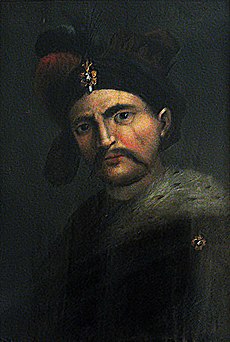
Back Abbas I. (Persien) ALS عباس الأول الصفوي Arabic عباس الاول الصفوى ARZ Abás el Grande AST I Abbas Azerbaijani بیرینجی شاه عباس صفوی AZB Ғәббәс I Bashkir Абас I Вялікі Byelorussian Абас I Велики Bulgarian প্রথম আব্বাস (পারস্য) Bengali/Bangla
| Abbas I the Great | |||||
|---|---|---|---|---|---|
| Šāhanšāh-i Īrān (King of Kings of Iran)[1][2][3] Ẓellollāh (Shadow of God)[4] Ṣāḥeb-i Qerān-i ʿAlāʾ (Supreme Lord of the Auspicious Conjunction)[5] | |||||
 Shah Abbas I in a 16th or 17th century portrait[6] | |||||
| Shah of Iran | |||||
| Reign | 1 October 1587 – 19 January 1629 | ||||
| Coronation | 1588 | ||||
| Predecessor | Mohammad Khodabanda | ||||
| Successor | Safi | ||||
| Born | 27 January 1571 Herat, Safavid Iran (modern-day Afghanistan) | ||||
| Died | 19 January 1629 (aged 57) Behshahr, Mazandaran, Safavid Iran | ||||
| Burial | |||||
| Consort |
| ||||
| Issue | See below | ||||
| |||||
| Dynasty | Safavid | ||||
| Father | Mohammad Khodabanda | ||||
| Mother | Khayr al-Nisa Begum | ||||
| Religion | Shia Islam | ||||
Abbas I (Persian: عباس یکم, romanized: ʿAbbās; 27 January 1571 – 19 January 1629), commonly known as Abbas the Great (Persian: عباس بزرگ, romanized: ʿAbbās-e Bozorg), was the fifth shah of Safavid Iran from 1588 to 1629. The third son of Shah Mohammad Khodabanda, he is generally considered one of the greatest rulers of Iranian history and the Safavid dynasty.
Although Abbas would preside over the apex of Safavid Iran's military, political and economic power, he came to the throne during a troubled time for the country. Under the ineffective rule of his father, the country was riven with discord between the different factions of the Qizilbash army, who killed Abbas' mother and elder brother. Meanwhile, Iran's enemies, the Ottoman Empire (its archrival) and the Uzbeks, exploited this political chaos to seize territory for themselves. In 1588, one of the Qizilbash leaders, Murshid Qoli Khan, overthrew Shah Mohammed in a coup and placed the 16-year-old Abbas on the throne. However, Abbas soon seized power for himself.
Under his leadership, Iran developed the ghilman system where thousands of Circassian, Georgian, and Armenian slave-soldiers joined the civil administration and the military. With the help of these newly created layers in Iranian society (initiated by his predecessors but significantly expanded during his rule), Abbas managed to eclipse the power of the Qizilbash in the civil administration, the royal house, and the military. These actions, as well as his reforms of the Iranian army, enabled him to fight the Ottomans and Uzbeks and reconquer Iran's lost provinces, including Kakheti whose people he subjected to widescale massacres and deportations. By the end of the 1603–1618 Ottoman War, Abbas had regained possession over Transcaucasia and Dagestan, as well as swaths of Eastern Anatolia and Mesopotamia. He also took back land from the Portuguese and the Mughals and expanded Iranian rule and influence in the North Caucasus, beyond the traditional territories of Dagestan.
Abbas was a great builder and moved his kingdom's capital from Qazvin to Isfahan, making the city the pinnacle of Safavid architecture. In his later years, following a court intrigue involving several leading Circassians, Abbas became suspicious of his own sons and had them killed or blinded.
- ^ George Lenczowski, "Iran under the Pahlavis", Hoover Institution Press, 1978, p. 79
- ^ Stefan Sperl, C. Shackle, Nicholas Awde, "Qasida poetry in Islamic Asia and Africa", Brill Academic Pub; Set Only edition (February 1996), p. 193
- ^ Heinz Halm, Janet Watson, Marian Hill, Shi'ism, translated by Janet Watson, Marian Hill, Edition: 2, illustrated, published by Columbia University Press, 2004, p. 80
- ^ Quinn 2015, chpt. Shah Abbas and political legitimacy'
- ^ Quinn 2015, chpt.Shah Abbas as the 'Supreme Lord of the Auspicious Conjunction'
- ^ Amanat 2017, p. 77.
© MMXXIII Rich X Search. We shall prevail. All rights reserved. Rich X Search